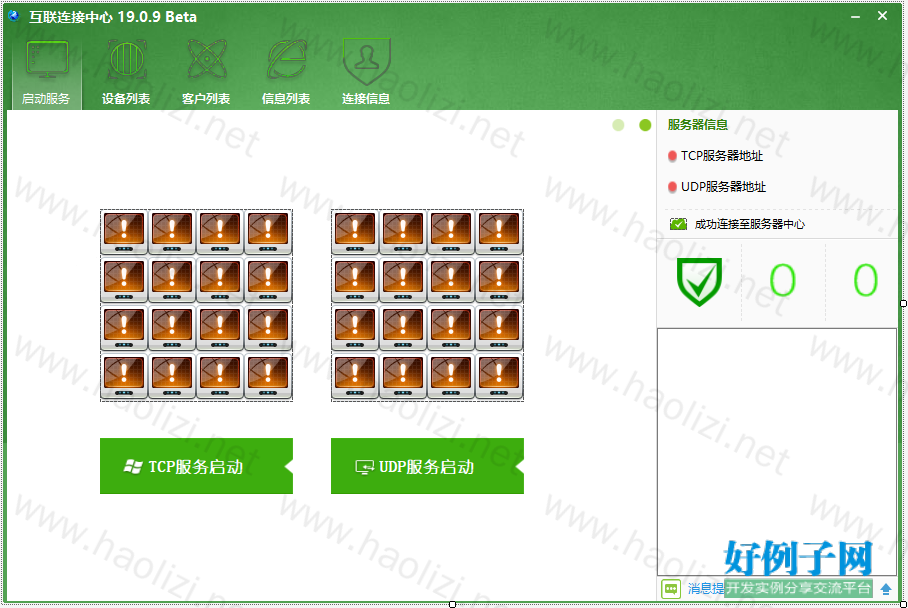实例介绍
【实例简介】
C#开发的高性能soket 服务器提供TCP服务端与UDP服务端的管理工具
【实例截图】


【核心代码】
/********************************************************************
* * 使本项目源码前请仔细阅读以下协议内容,如果你同意以下协议才能使用本项目所有的功能,
* * 否则如果你违反了以下协议,有可能陷入法律纠纷和赔偿,作者保留追究法律责任的权利。
* *
* * Copyright (C) 2014-? cskin Corporation All rights reserved.
* * 作者: Amos Li QQ:382689696 .Net项目技术组群:Amos Li 出品
* * 请保留以上版权信息,否则作者将保留追究法律责任。
* * 创建时间:2014-08-05
********************************************************************/
using System;
using System.Net;
using System.Net.Sockets;
using System.Text;
namespace SocketServerCommonLib
{
/// <summary>
/// 服务器-同步监听端口、异步发送数据
/// </summary>
public class AsyncSocketServer
{
private Socket listenSocket;
/// <summary>
/// 是否已启动监听
/// </summary>
public bool IsStartListening = false;
/// <summary>
/// 服务器配置
/// </summary>
private ServerConfig Serverconfig { get; set; }
public ServerConfig serverconfig
{
get { return Serverconfig; }
set { Serverconfig = value; }
}
/// <summary>
/// 用户集合
/// </summary>
private SocketUserClientList m_asyncSocketUserList;
public SocketUserClientList AsyncSocketUserList { get { return m_asyncSocketUserList; } }
/// <summary>
/// 用户池定义
/// </summary>
private AsyncSocketUserPool m_asyncSocketUserTokenPool;
/// <summary>
/// 设备集合(通讯的话此处无需管理)
/// </summary>
private SocketDeviceClientList m_asyncSocketDeviceList;
public SocketDeviceClientList AsyncSocketDeviceList
{
get { return m_asyncSocketDeviceList; }
set { m_asyncSocketDeviceList = value; }
}
/// <summary>
/// 用户池初始化
/// </summary>
public void Init()
{
Serverconfig = new ServerConfig();
m_asyncSocketUserList = new SocketUserClientList();
m_asyncSocketDeviceList = new SocketDeviceClientList();
m_asyncSocketUserTokenPool = new AsyncSocketUserPool(serverconfig.numConnections);
SocketUserToken userToken;
for (int i = 0; i < serverconfig.numConnections; i ) //按照连接数建立读写对象
{
userToken = new SocketUserToken(serverconfig.buffSize);
//异步回调函数初始化
userToken.ReceiveEventArgs.Completed = new EventHandler<SocketAsyncEventArgs>(IO_Completed);
//异步回调函数初始化
userToken.SendEventArgs.Completed = new EventHandler<SocketAsyncEventArgs>(IO_Completed);
//开辟固定空间
m_asyncSocketUserTokenPool.Push(userToken);
}
}
/// <summary>
/// 异步发送及接收回调函数
/// </summary>
/// <param name="sender"></param>
/// <param name="e"></param>
private void IO_Completed(object sender, SocketAsyncEventArgs asyncEventArgs)
{
SocketUserToken userToken = asyncEventArgs.UserToken as SocketUserToken;
userToken.ActiveDateTime = DateTime.Now;
try
{
lock (userToken)
{
if (asyncEventArgs.LastOperation == SocketAsyncOperation.Receive)
ProcessReceive(asyncEventArgs);
else if (asyncEventArgs.LastOperation == SocketAsyncOperation.Send)
ProcessSend(asyncEventArgs);
else
throw new ArgumentException("最后一次操作完成套接字接收或发送");
}
}
catch (Exception ex)
{
DelegateState.ServerStateInfo("异步发送及接收回调函数: IO_Completed " userToken.ConnectSocket " error, message: " ex.Message);
}
}
/// <summary>
/// 异步发送回调函数
/// </summary>
/// <param name="asyncEventArgs"></param>
private bool ProcessSend(SocketAsyncEventArgs sendEventArgs)
{
SocketUserToken userToken = sendEventArgs.UserToken as SocketUserToken;
userToken.ActiveDateTime = DateTime.Now;
if (sendEventArgs.SocketError == SocketError.Success)
return userToken.InvokeElement.SendCompleted(userToken); //调用子类回调函数
else
{
CloseClientSocket(userToken);
return false;
}
}
/// <summary>
/// 异步发送
/// </summary>
/// <param name="connectSocket">Socket</param>
/// <param name="sendEventArgs">SocketAsyncEventArgs</param>
/// <param name="buffer">byte[]</param>
/// <param name="offset">int</param>
/// <param name="count">int</param>
/// <returns>bool</returns>
public bool SendAsyncEvent(Socket connectSocket, SocketAsyncEventArgs sendEventArgs, byte[] buffer, int offset, int count)
{
if (connectSocket == null)
return false;
sendEventArgs.SetBuffer(buffer, offset, count);//设置缓冲区域
bool willRaiseEvent = connectSocket.SendAsync(sendEventArgs);//异步发送
if (!willRaiseEvent)
{
return ProcessSend(sendEventArgs);
}
else
return true;
}
/// <summary>
/// 启动服务器
/// </summary>
/// <param name="localEndPoint"></param>
public void Start()
{
if (IsStartListening)
return;
IsStartListening = true;
Init();
listenSocket = new Socket(serverconfig.locahostEndPoint.AddressFamily, SocketType.Stream, ProtocolType.Tcp);
listenSocket.Bind(serverconfig.locahostEndPoint);
listenSocket.Listen(serverconfig.numConnections);
DelegateState.ServerStateInfo("TCP服务器启动...");
StartAccept(null);
serverconfig.m_daemonThread = new DaemonThread(this);//启动连接超时判断
}
/// <summary>
/// 监听程序
/// </summary>
/// <param name="acceptEventArgs"></param>
public void StartAccept(SocketAsyncEventArgs acceptEventArgs)
{
if (acceptEventArgs == null)//第一运
{
//acceptEventArgs == null 绑定异步回调函数AcceptEventArg_Completed
acceptEventArgs = new SocketAsyncEventArgs();
acceptEventArgs.Completed = new EventHandler<SocketAsyncEventArgs>(AcceptEventArg_Completed);
}
else
{
//为什么没有while ? AcceptEventArg_Completed()异步回调函数中递归了StartAccept()方法
//再次调用StartAccept()方法时候AcceptSocket处于上一个用户的绑定状态,所以释放上次绑定的Socket,等待下一个Socket连接
acceptEventArgs.AcceptSocket = null;
}
serverconfig.semap.WaitOne();//减少个一信号量 ,退出时候会返回
//异步监控:回调函数AcceptEventArg_Completed
bool willRaiseEvent = listenSocket.AcceptAsync(acceptEventArgs);
if (!willRaiseEvent)
{
//不成功再次连接
ProcessAccept(acceptEventArgs);
}
}
/// <summary>
/// 异步监控回调函数
/// </summary>
private void AcceptEventArg_Completed(object sender, SocketAsyncEventArgs e)
{
try
{
ProcessAccept(e);
}
catch (Exception ex)
{
DelegateState.ServerStateInfo("连接异常:" ex.Message);
//DelegateState.ServerStateInfo(ex.StackTrace);
}
}
/// <summary>
/// 添加新客户
/// </summary>
/// <param name="acceptEventArgs"></param>
private void ProcessAccept(SocketAsyncEventArgs acceptEventArgs)
{
if (acceptEventArgs.AcceptSocket.RemoteEndPoint == null)
throw new Exception("服务器停止.");
DelegateState.ServerStateInfo(" TCP - 客户端:" acceptEventArgs.AcceptSocket.RemoteEndPoint "连接");
DelegateState.ServerConnStateInfo(acceptEventArgs.AcceptSocket.RemoteEndPoint.ToString(), "TCP");
SocketUserToken userToken = m_asyncSocketUserTokenPool.Pop();
m_asyncSocketUserList.Add(userToken);
userToken.ConnectSocket = acceptEventArgs.AcceptSocket;
userToken.ConnectDateTime = DateTime.Now;
try
{
bool willRaiseEvent = userToken.ConnectSocket.ReceiveAsync(userToken.ReceiveEventArgs);//异步回调函数确定
if (!willRaiseEvent)
{
lock (userToken)
{
ProcessReceive(userToken.ReceiveEventArgs);
}
}
}
catch (Exception e)
{
DelegateState.ServerStateInfo("连接端 " userToken.ConnectSocket " 错误, 错误信息: " e.Message);
}
StartAccept(acceptEventArgs);//递归继续异步监控客户端
}
/// <summary>
/// 异步接收请求
/// </summary>
/// <param name="socketAsyncEventArgs"></param>
private void ProcessReceive(SocketAsyncEventArgs socketAsyncEventArgs)
{
SocketUserToken userToken = socketAsyncEventArgs.UserToken as SocketUserToken;
if (userToken.ConnectSocket == null)
return;
userToken.ActiveDateTime = DateTime.Now;
if (userToken.ReceiveEventArgs.BytesTransferred > 0 && userToken.ReceiveEventArgs.SocketError == SocketError.Success)
{
int offset = userToken.ReceiveEventArgs.Offset;
int count = userToken.ReceiveEventArgs.BytesTransferred;
if ((userToken.InvokeElement == null) & (userToken.ConnectSocket != null)) // 第一次发送的数据为-初始话是登录模式 还是 信息模式
{
BuildingInvokeElement(userToken);
offset = offset 1;
count = count - 1;
}
if (userToken.InvokeElement == null) //如果没有解析对象,提示非法连接并关闭连接
{
DelegateState.ServerStateInfo("非法连接:" userToken.ConnectSocket.RemoteEndPoint);
CloseClientSocket(userToken);
}
else
{
if (count > 0) //处理接收数据
{
if (!userToken.InvokeElement.ProcessReceive(userToken.ReceiveEventArgs.Buffer, offset, count))//处理数据
{
//如果处理数据返回失败,则断开连接
CloseClientSocket(userToken);
}
else
{
bool willRaiseEvent = userToken.ConnectSocket.ReceiveAsync(userToken.ReceiveEventArgs); //继续异步接收
if (!willRaiseEvent)
ProcessReceive(userToken.ReceiveEventArgs);
}
}
}
}
else
{
DelegateState.ServerStateInfo(string.Format("空数据,断线 {0}",
userToken.ConnectSocket.RemoteEndPoint));
CloseClientSocket(userToken);
}
}
/// <summary>
/// 初始化类,确定是登录或者发送信息 和其它的API
/// </summary>
/// <param name="userToken"></param>
private void BuildingInvokeElement(SocketUserToken userToken)
{
//获取接收的0个字节-初始化是登录还是信息
byte flag = userToken.ReceiveEventArgs.Buffer[userToken.ReceiveEventArgs.Offset];
if (flag == (byte)ProtocolFlags.Login)
userToken.InvokeElement = new LoginSocketProtocol(this, userToken);
if (userToken.InvokeElement != null)
{
DelegateState.ServerStateInfo(userToken.ConnectSocket.RemoteEndPoint "登录初始化");
}
}
/// <summary>
/// 清除客户端
/// </summary>
/// <param name="userToken"></param>
public void CloseClientSocket(SocketUserToken userToken)
{
if (userToken.ConnectSocket == null)
return;
DelegateState.ReomveTCPStateInfo(userToken);
string socketInfo = string.Format(" 删除地址: {0}",
userToken.ConnectSocket.RemoteEndPoint);
try
{
userToken.SendUserTokenAll.Clear();//清除设备连接
userToken.ConnectSocket.Shutdown(SocketShutdown.Both);
}
catch (Exception E)
{
DelegateState.ServerStateInfo("断开连接 " socketInfo " error, message: {1}" E.Message);
}
userToken.LoginFlag = false;
userToken.ConnectSocket.Close();
userToken.ConnectSocket = null; //释放引用,并清理缓存,包括释放协议对象等资源
serverconfig.semap.Release();//增加个一信号量
m_asyncSocketUserTokenPool.Push(userToken);
AsyncSocketUserList.Remove(userToken);
}
/// <summary>
/// 发送信息
/// </summary>
/// <param name="commandText">string</param>
/// <param name="userToken">SocketUserToken 连接客户端</param>
/// <returns>bool</returns>
public bool SendMsgClientMsg(string commandText, SocketUserToken userToken)
{
byte[] bufferUTF8 = Encoding.UTF8.GetBytes(commandText);
int totalLength = bufferUTF8.Length; //获取总大小
AsyncSendBufferManager asyncSendBufferManager = userToken.SendBuffer;
asyncSendBufferManager.StartPacket();
asyncSendBufferManager.m_dynamicBufferManager.WriteBuffer(bufferUTF8); //写入命令内容
asyncSendBufferManager.EndPacket();
bool result = true;
if (!userToken.m_sendAsync)
{
int packetOffset = 0;
int packetCount = 0;
if (asyncSendBufferManager.GetFirstPacket(ref packetOffset, ref packetCount))
{
userToken.m_sendAsync = true;
result = SendAsyncEvent(userToken.ConnectSocket, userToken.SendEventArgs,
asyncSendBufferManager.m_dynamicBufferManager.Buffer, packetOffset, packetCount);
}
}
return result;
}
/// <summary>
/// 停止服务器
/// </summary>
public void Stop()
{
Serverconfig.m_daemonThread.Close();
IsStartListening = false;
listenSocket.Close();
m_asyncSocketUserList.Userlist = null;
m_asyncSocketDeviceList = null;
GC.Collect();
}
}
}
小贴士
感谢您为本站写下的评论,您的评论对其它用户来说具有重要的参考价值,所以请认真填写。
- 类似“顶”、“沙发”之类没有营养的文字,对勤劳贡献的楼主来说是令人沮丧的反馈信息。
- 相信您也不想看到一排文字/表情墙,所以请不要反馈意义不大的重复字符,也请尽量不要纯表情的回复。
- 提问之前请再仔细看一遍楼主的说明,或许是您遗漏了。
- 请勿到处挖坑绊人、招贴广告。既占空间让人厌烦,又没人会搭理,于人于己都无利。
关于好例子网
本站旨在为广大IT学习爱好者提供一个非营利性互相学习交流分享平台。本站所有资源都可以被免费获取学习研究。本站资源来自网友分享,对搜索内容的合法性不具有预见性、识别性、控制性,仅供学习研究,请务必在下载后24小时内给予删除,不得用于其他任何用途,否则后果自负。基于互联网的特殊性,平台无法对用户传输的作品、信息、内容的权属或合法性、安全性、合规性、真实性、科学性、完整权、有效性等进行实质审查;无论平台是否已进行审查,用户均应自行承担因其传输的作品、信息、内容而可能或已经产生的侵权或权属纠纷等法律责任。本站所有资源不代表本站的观点或立场,基于网友分享,根据中国法律《信息网络传播权保护条例》第二十二与二十三条之规定,若资源存在侵权或相关问题请联系本站客服人员,点此联系我们。关于更多版权及免责申明参见 版权及免责申明



网友评论
我要评论